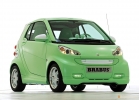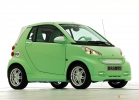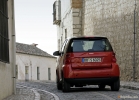Smart Fortwo test drive since 2007 hatchback
Short against little: Smart Fortwo and Toyota IQ in comparison
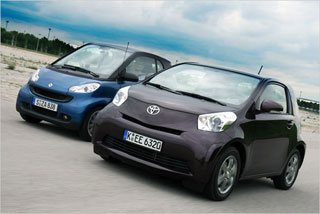 Rear -wheel drive with a semiautomatic device against the front -wheel drive with the variator
Rear -wheel drive with a semiautomatic device against the front -wheel drive with the variator Take a look at the consolidated table of characteristics, and you almost accurately determine the difference in the length of our test participants. The king’s title of close parking is still owned by Smart Fortwo, but Toyota IQ 2.99 meters long literally steps on his heels, only 30 centimeters behind. In addition, the Japanese is ready to offer seats for four people, at least formally. Is the baby from the Far East is able to overthrow the aged representative of Lorraine from the throne?
Engine and transmission
For comparison, we chose the IQ version with a 68-horsepower liter gasoline engine, and the Fortwo model is equipped with a 71-horsepower liter engine. Both units have not only almost the same power and working volume. They both have three cylinders, and torque they give out almost the same. When touched by IQ, a failure is observed in traction, but at a slightly higher speed it rides quarrel than Smart. In addition, at idle, the Toyota three -cylinder engine emits significant vibration, Smart almost does not sin this. But while driving, Smart is much more noisy.
Semi -automatic against the variator
How much tested cars are similar along the engines, they are just as much differ in the concepts of the drive and transmission. Smart's rear -wheel drive, Toyota, on the contrary, is front. In addition, Fortwo has an automated gearbox, which in this configuration Passion has manual and automatic modes, as well as steering wheel transfers. Due to this, Smart'a has a pause with each gear shift. Our IQ is equipped with an option in the form of a stepless automatic variator, and it is much more comfortable to travel with it. True, there is no way to manually choose a program.
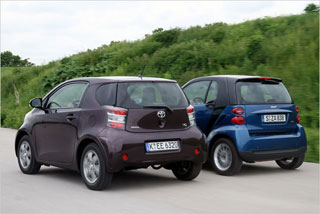 The same consumption
The same consumption Fortwo 1.0 MHD has a stop start system for all configurations, IQ has such a function only for the IQ+version. And although Toyota more in size, with a mechanical gearbox, IQ consumes 0.1 liters of fuel less than Smart: according to factory characteristics, the consumption is 4.3 liters per 100 kilometers. Both cars belong to the most economical gasoline cars in the market. IQ with the variator consumes as many as 4.7 liters. In practice, Smart showed a 6.0 -liter consumption, and IQ of 7.5 liters. Both engines correspond only to Euro-4 standards.
Low maximum speed
Our low -profiles are not created for autobahns, and regarding the maximum speed, we need to make amendments: according to the characteristics, Smart accelerates to 145 km/h, and the limit for IQ is 150 km/h. We managed to disperse Smart to 150 km/h, and IQ speedometer showed even 165 km/h.
Chassis and control
In addition to a relatively low maximum speed, the suitability of our cars for an autobahn also reduce the design and settings of the chassis. At about a speed of 120 km/h in Smart, it becomes scary, while IQ retains stability. The same applies to turns: if you go too fast in a bend, then getting out of it is easier on IQ. When Smart's tires already screech and the ESP indicator lights up, IQ at the same speed does not have any problems. Fortunately, both cars have an electronic system of protection against drifts, and to this day, such an assistant is not installed on all small -profiles. But the power steering is serial equipment only for IQ. And in the direct section of Toyota is also more pleasant. Since Smart rides on bumps, it has a much more rigid suspension than IQ, which easily rolls along the cracks, furrows and cones of the roadway. It should be added to this that when braking and automatic change of transmission, Smart almost always freezes, which further enhances the manifestation of the mentioned overheard in the thrust. Speaking of braking: Smart'a, unlike IQ, is only a drum brake from behind.
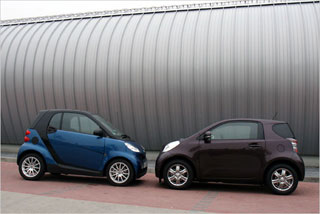 Body and salon
Body and salon As mentioned earlier, having a length of 2.99 meters, IQ is almost 30 centimeters longer than Smart'a. But in the wheelbase, the difference is only 13 centimeters. However, formally, Toyota has four seats, while Smart can offer only two. Nevertheless, the seat located behind the driver’s chair IQ is completely not suitable for an adult passenger, and even the child will fit there only on condition that the driver has small dimensions. But in the rear seat behind the passenger’s armchair there is enough space for the legs, since due to the asymmetric dashboard, the front seat can be more extended forward. There are very few places over the head of adults in the back seat, but with a great desire, IQ can be called a car with 3+1 seats.
A little luggage space
As it should be expected, in both cars there is little place for baggage. But IQ in this regard is still a little better. Of course, in a four -seater version, the baggage will not fit at all, but the rear seats can be folded. Thus, a flat, suitable surface for operation appears, on which you can place 395 liters of baggage, if you use the space to the ceiling. Of course, this is not much, because even in Fiat 500, after folding the seats, more than 600 liters fit. But Smart's abilities are even less - only 340 liters. Even if you put the passenger seat in Smart'e, it climbs more in IQ.
Frontal crash test IQ
The topic of safety during the accident is especially important in the case of cars that do not have a large protective surface of the body. Here Toyota turns out to be ahead, having received five stars at the Euro-NCAP crash test, and Smart'y had to be content with only four. Passive safety is presented in Smart'e with two serial airbags, but IQ has as many as nine: in addition to the front pillows, side fronts and heads, there are two more pillows for knees, as well as rear airbags that have become world premiere and designed for Protection of passengers from behind.
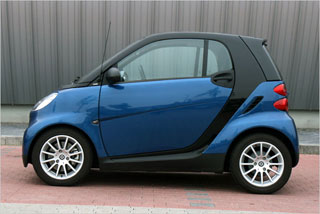 Good materials in Smart'e
Good materials in Smart'e Fortwo liked the salon more. Instead of hard plastic, the toolbar is covered with an extraordinary and convincing solution with the corresponding fabric. But the speedometer dial looks somewhat cold. IQ materials and colors disappointed us. But the Japanese’s seat is definitely better. They also do not provide proper side support, but they are softer and more convenient than hard Smart's buckets.
Complete and price
When Smart appeared on sale in 1998, many complained about its high cost of 16,480 German brands (8,426 euros) for the same money at one time could buy Fiat Seicento or Ford KA. And the current price of 9,990 euros looks immodest when compared with Dacia Sandero and other budget cars with four full seats. And our model Smart'a with a capacity of 71 hp. And in the most expensive configuration, Passion is generally sold at a price of 12,700 euros. Toyota asks for IQ 1.0 with a mechanical box. For a model with a variator, you will have to pay at least 13,900 euros. Whether such an almost 10%allowance is justified in price, everyone decides for himself, we could easily abandon the options. If the variator is also reckoned with options, then IQ goes 1,200 euros more expensive than Smart'a.
iQ is better equipped
In general, Toyota provides better equipment. Like Smart, IQ is equipped with a central locking lock, electric windows with electric drive, air conditioning and 15-inch wheels with aluminum disks are not bad for the smallest car. In addition, IQ has, as already mentioned, nine airbags, and not two. In addition, the Japanese has a system of electronic adjustment and heating of the rear view mirrors, for which Smart would have to pay 160 euros. In addition, the standard IQ set includes a radio receiver with a CD player, and in Smart, this is a paid option. For its part, Fortwo boasts only an anti -leaving system, which IQ does not have.
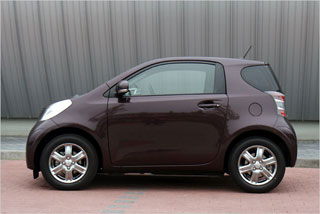 Grade
Grade In the category, the engine and the transmission wins IQ mainly because the semiautomatic device Smart'a is too annoying. The motors for candidates for characteristics are approximately the same. In terms of Toyota suspension, it turns out to be more stable and comfortable. When comparing the bodies, the same picture: IQ is larger than space, and it is better passing through the Euro-NCAP crash test. And what about the price? Finally, IQ with the best equipment costs as much as Smart. We would not order an expensive variator for the Japanese. As a result, IQ won a confident victory. We were also convinced of this excellent level of comfort when moving, soundproofing and convenient transfers, as well as a large capacity.
Smart Fortwo. 4 points out of 5
Pros: cheaper than IQ with a variator
Cons: noise, roar, annoying interruptions with traction
Toyota IQ. 4.5 points out of 5
Pros: a significantly higher level of comfort, a more spacious interior
Cons: expensive variator
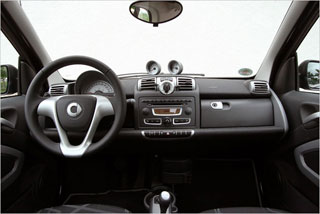
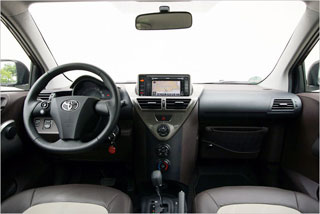
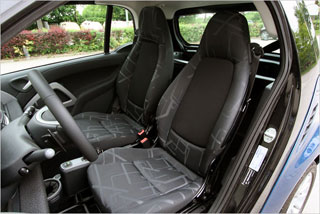
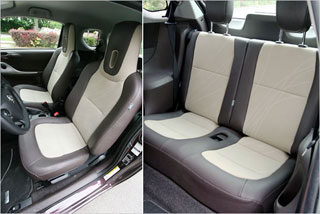
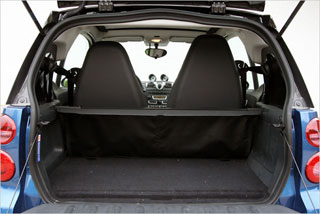
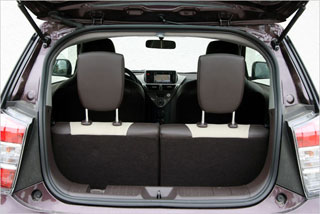
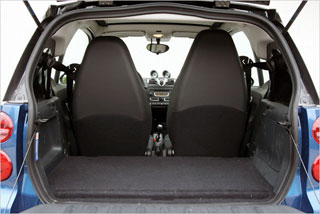
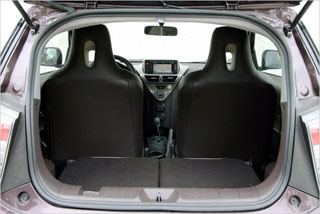
Specifications
Smart Fortwo 1.0 MHD Toyota IQ 1.0 CVT
Engine and drive
Type of motor atmospheric gasoline atmospheric gasoline
The number of cylinders 3 3
The number of valves per cylinder 4 4
Working volume in the cubic meter 999 998
Power in L.S. 71 68
Power in kW 52 50
at rpm 5 800 6 000
Torque in NM 92 91
at rpm 4 500 4 800
The rear front drive
Transmission Automated 5-speed box with manual mode variator
Chassis
Front wheels, tires 15-inch cast discs, tires 155/60 R15 15-inch cast discs, tires 175/65 R15
Rear wheels, tires 15-inch cast discs, tires 175/55 R15 the same as in front
Dimensions and masses
Length in mm 2 695 2 985
Width in mm 1 559 1 680
Height in mm 1 542 1 500
Wheel base in mm 1 867 2 000
Own mass in kg 825 860
Permissible load in kg 195 350
The volume of the luggage compartment in liters 220 238
Adjustable luggage compartment in liters 340 395
Volume of gas tank in liters 33 32
Speed \u200b\u200bcharacteristics and consumption
Maximum speed in km/hour 145 150
Acceleration 0-100 km/h 13.3 no data
Average consumption in l/100 km 4.4 4.7
Consumption in the city in l/100 km 5.2 5.7
City consumption in l/100 km 3.9 4.1
Extrication CO2 in g/km 104 110
Classification by ejaculation of harmful substances Euro-4 Euro-4
Prices
Smart Fortwo 1.0 MHD Passion Toyota IQ 1.0 CVT
Basic cost 12 700 13 900
Currency euro euro
ABS + +
ESP + +
Driver safety pillow + +
Passenger safety pillow + +
Side pillows in front 290 +
Electric winding windows + + +
Electronic adjustment of the rear view mirrors 190 +
Air conditioning - +
Climate control + -
Central Castle with remote control + +
Radio receiver with 450 CD player (including mp3) + (including mp3)
Metallic color 290 400
Alloy wheels + (15 inches) + (15 inches)
Leather finish of the cabin 475 800
Fog lights 190 -
A source: heise Autos


